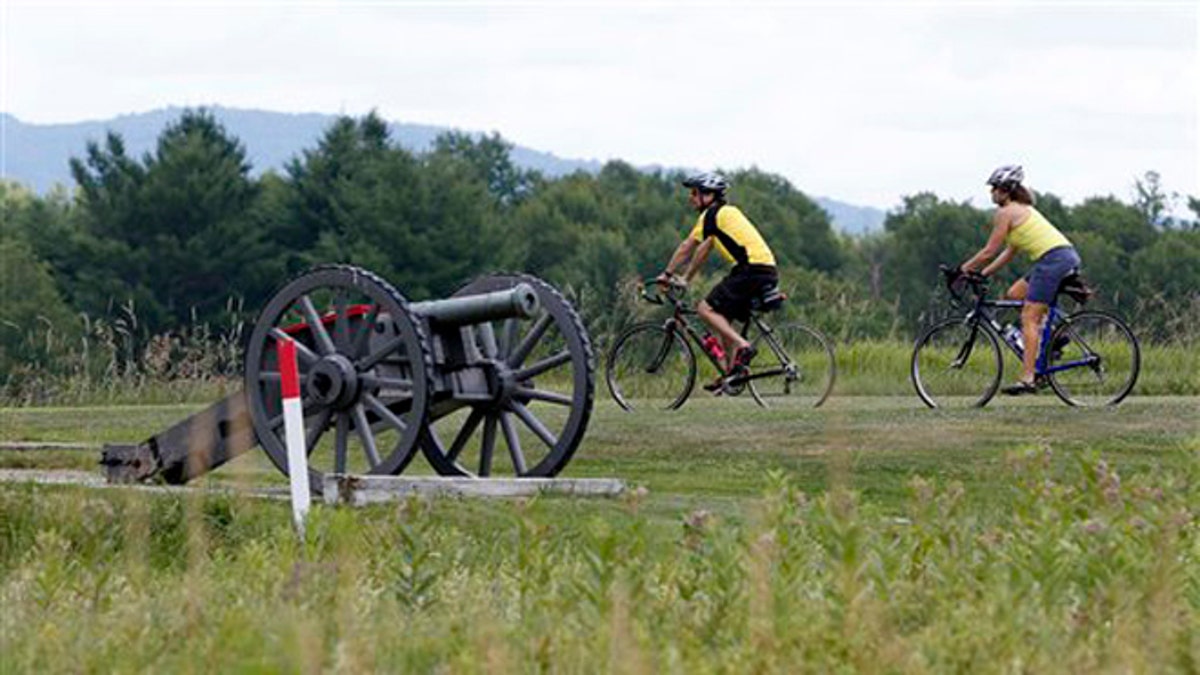
July 2, 2012: Eric Epstien, left, and Isabelle Davidowitz, of Braddock Heights, Md., ride past a cannon on a bike tour of Saratoga National Historical Park in Stillwater, N.Y. (AP)
STILLWATER, N.Y. – Ranger Megan Stevens sets a leisurely pace as she leads about a dozen bicyclists along the paved tour road at Saratoga National Historical Park, scene of one of history's most important battles.
About midway up one of the steeper inclines, it becomes apparent why the Americans made sure they held the high ground when the redcoats finally showed up — on foot — in 1777.
"You can see how impressive the valley is," Stevens said afterward about some of the park's hilltop views of the upper Hudson River in Stillwater, 20 miles north of Albany.
From such scenic spots she and other National Park Service rangers regale groups of bicyclists with stories of the two battles fought here in September and October 1777, their outcomes, and how the Continental Army's defeat of the world's best army led to the eventual American victory in the Revolutionary War.
The free guided bike tours are conducted every other Wednesday in the summer beginning in June at the park, also known as the Saratoga Battlefield. No tour is scheduled Wednesday because of Fourth of July events being held at the park.
Other guided bike tours are scheduled for July 11 and 25, and Aug. 1, 15 and 29. They begin at 6 p.m. in the park's parking lot and last until about 8 p.m. Participants must bring their own bicycles.
The bike tours offer an opportunity to learn about a battle considered one of the most significant in history, while getting a not-too-strenuous workout at the same time. An added bonus: Plenty of panoramic views along the 5-mile route, with mountaintops in neighboring Vermont and even some in western Massachusetts visible when conditions are right.
On one recent pleasant evening, a group consisting of middle-aged couples and retirees pedaled behind Stevens as she led the way from the parking lot outside the park's visitors center to stop No. 2, site of the Neilson House.
Standing near a small building, the only original Revolution-era structure remaining at the park, Megan tells the group how the entire Neilson family — husband, wife, eight children and a grandparent — lived in a house about the size of a one-car garage.
During the Saratoga battles, the homestead served as the headquarters of the American army's left wing, commanded by Maj. Gen. Benedict Arnold, with several thousand troops encamped behind a zigzagging line of log and earthen fortifications that stretched more than a mile along a ridge overlooking the valley.
The Americans' command of the high ground forced British Gen. John Burgoyne's army of redcoats and German allies to veer into the rugged interior, away from the river. Burgoyne hoped to brush aside the enemy and continue his southward advance, with the goal of capturing Albany and isolating New England from the rest of the 13 colonies.
But after clashes on Sept. 19 and Oct. 7, Burgoyne's army was beaten, exhausted and starving. The British surrendered on Oct. 17, 1777, in the nearby village of Saratoga, later renamed Schuylerville after an American general from Albany who had land holdings here.
While giving a boiled-down version of the Saratoga battles is necessitated by the brevity of the stops during the bike tours, the rangers manage to include of some of behind-the-scenes drama, such as the personality clashes between American Maj. Gen. Horatio Gates and Arnold, a Saratoga hero who was still three years away from turning traitor.
"You can talk forever about the battle, but not everyone is interested in military things," Stevens said. "You connect more on personal level if you can talk about the individuals and what they went through."
If inclement weather forces cancellation of a bike tour, the rangers will hold their battlefield talks inside the visitors center.
For more information, call the park's visitor center at 518-664-9821, extension 1777, or check the park's website: www.nyps.gov/sara.
